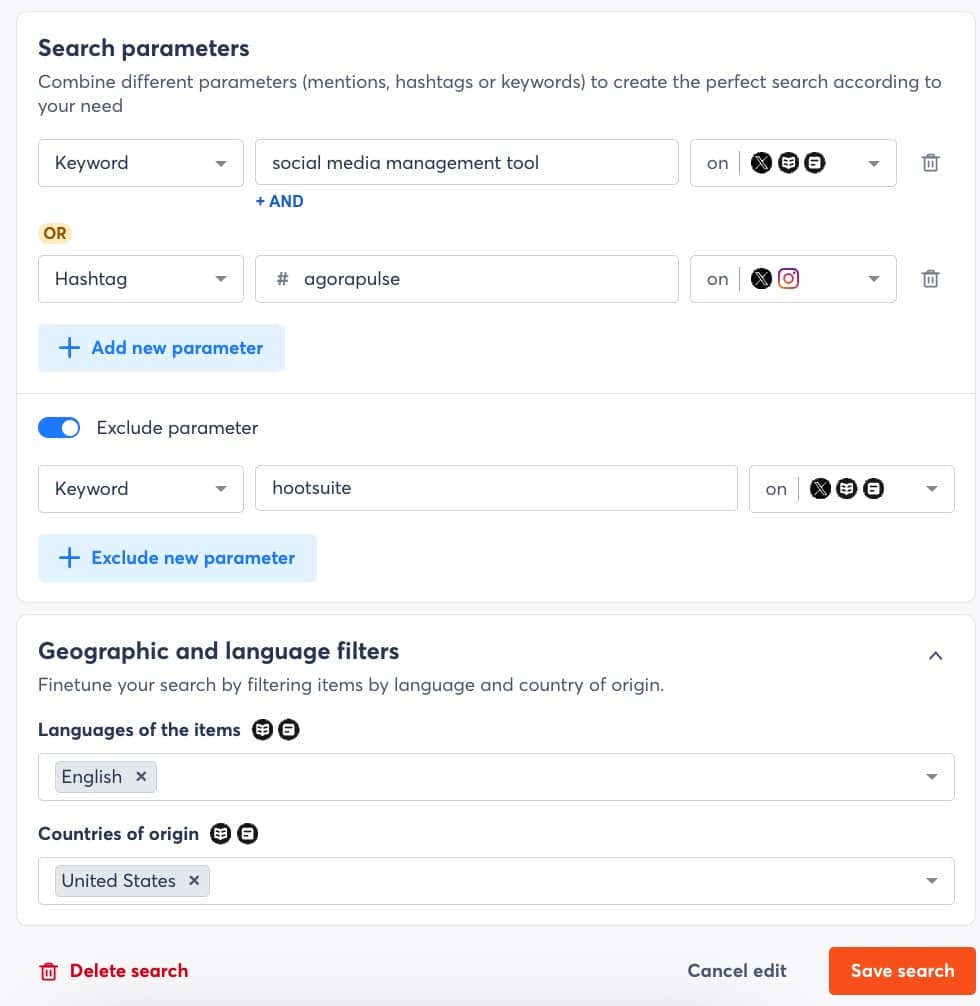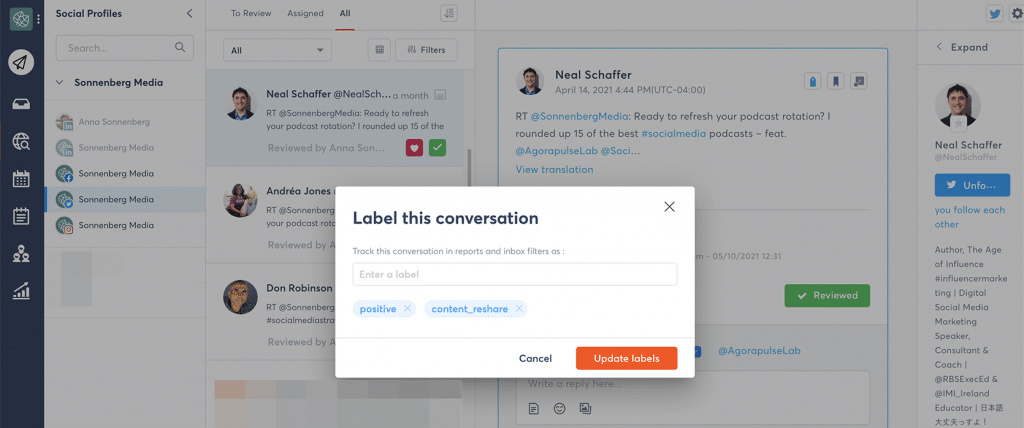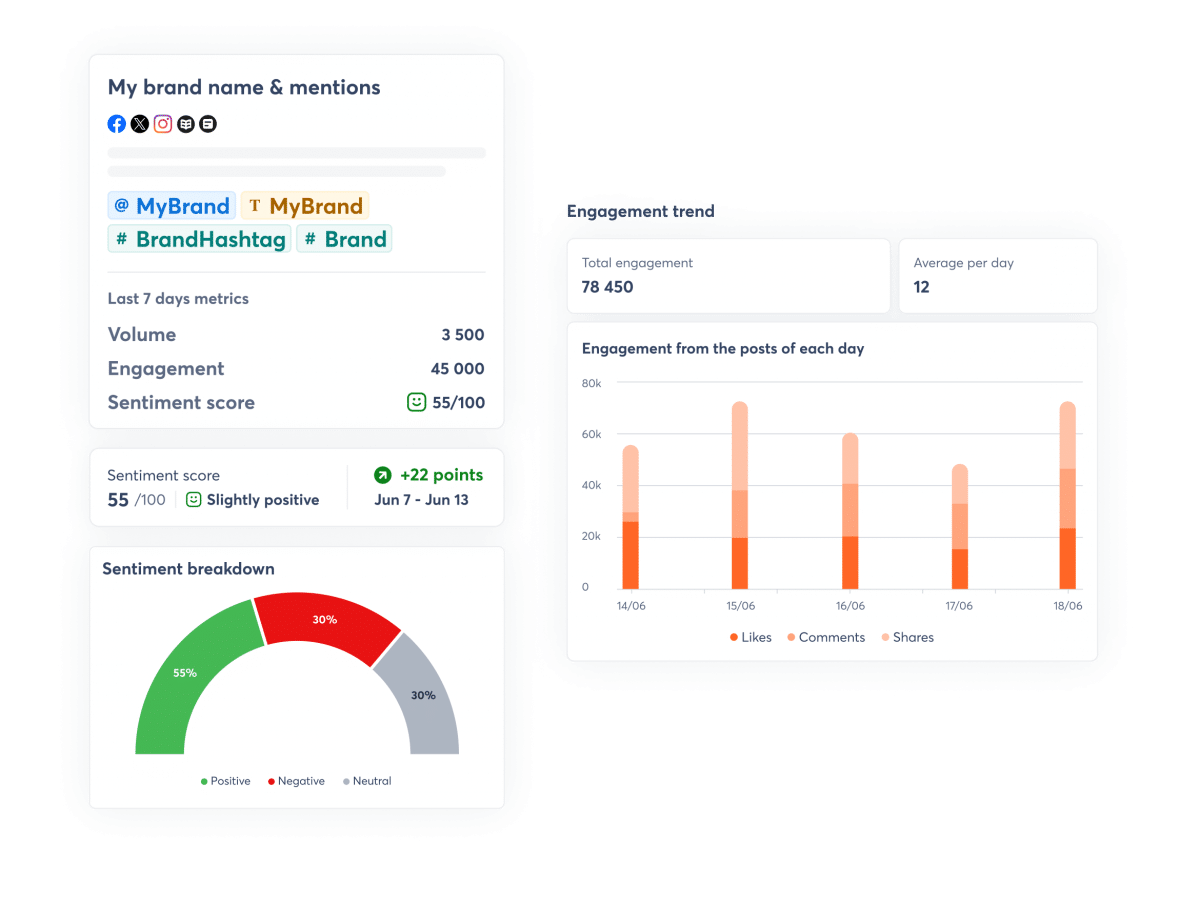Spotting future industry trends before they take off can set you apart and help your brand stand out as a leader, not a follower. Here’s how you can identify upcoming trends and figure out which ones are worth your time and resources.
How to Identify Industry Trends
To get ahead of the curve, start with these effective methods for uncovering emerging trends.
1. Social listening
You don’t want to sleep on using social listening for trend identification. Why? Because you don’t want to get left behind! According to a survey by McKinsey, 45% of high-performing companies use social listening tools to identify market trends.
What’s more interesting is that companies that use social listening tools are 2.5X more likely to become market leaders.
Agorapulse’s advanced social listening add-on will help you do just that. You can make searches that include your competitors’ brands, hashtags, or related keywords on the largest social networks like Facebook, Instagram, and X (Twitter), and across the web.
- Keyword monitoring: Track keywords relevant to your industry. For example, if you’re in fashion, monitor terms like “sustainable fashion” or “athleisure.”
- Hashtag analysis: Look at popular hashtags to see what topics are trending.
- Competitor analysis: Keep an eye on your competitors’ mentions across social media and the web to spot trends they’re engaging with, and also gauge public sentiment surrounding their brand.

Pro Tip: Use Agorapulse’s reporting features to identify patterns over time. What topics are consistently mentioned? What spikes in conversation correlate with industry events or new product launches?
2. Engage with industry influencers
Influencers always are on top of what is trending (mostly because they often are the ones creating the trends)! That’s why you should be following and interacting with the key influencers in your industry. It’s a low-lift win that can help you gain insights into emerging trends before they take off.
Don’t just passively follow; actively engage. Comment on influencers’ posts, share your thoughts, and build relationships. Doing so can open doors to more personalized insights and even future collaborations.
Pro Tip: When looking at the sentiment analysis for your listening search, try filtering the results by social network to identify if the sentiment score is different on each platform.
3. Attend conferences and trade shows
Industry events are a gold mine for trend spotting. They offer a firsthand look at what’s new and what’s next. Pay attention to the topics discussed in keynote speeches, the products showcased, and the companies getting the most buzz.
Pro Tip: Network with other attendees. Often the best insights come from casual conversations rather than formal presentations.
(On a side note, don’t forget to grab your spot at our upcoming Agency Summit on July 18th, which features insights from experts from Adobe, TikTok, LinkedIn, Google and others.)
4. Monitor industry publications and reports
Another way to spot trends early on is to subscribe to leading industry publications and regularly review market research reports. These sources often highlight emerging trends and provide data-rich and valuable insights that can be used to improve your products and services.
Here are some of the most valuable industry reports and research that you should watch for:
- Agorapulse’s State of Community Management Ebook: This report is the findings from our analysis of over 21 million social media posts. It covers the latest trends for social media publishing, such as the best time to post, or the type of content that is getting the most engagement. Download the (ungated!) report for useful insights that will help you get better results on social.
- McKinsey Global Institute Reports: McKinsey Global Institute publishes many highly valuable research reports each year, covering timely and relevant topics, such as productivity, technology, and market economics. Bonus: Everything published by the McKinsey Global Institute is available for free, unlike other sites, such as Statista or Gartner, which may have a paywall or subscription to access certain reports or data.
- Gartner’s Hype Cycle Reports: These reports published by Gartner provide info on the adoption of various technologies, and can be helpful for understanding how a technology or application will evolve over time. (However, these reports are reserved for paying Gartner clients.)
- Edelman Trust Barometer: This report measures trust across institutions globally and provides valuable insights into public sentiment. The latest version can be found on the Edelman website.
- HubSpot State of Marketing Report:
This annual report published by HubSpot provides insights into the latest marketing trends and benchmarks. - PwC’s Annual Global CEO Survey:
For perspectives of CEOs on the global economy, business growth, and emerging trends, the Annual Global CEO Survey is a good resource. For example, the 27th Global CEO Survey, published in January 2024, takes a deep dive into CEO perspectives on AI. - CB Insights’ State of Venture Reports: These reports cover trends in venture capital and startup activities and can be valuable resources for staying informed about market trends and making strategic business decisions. Find the report for Q2 2024 on the CB Insights website.
5. Analyze customer feedback and surveys
Reading industry reports will only get you so far. I wouldn’t recommend that you rely on them alone for identifying new trends.
Another overlooked but incredibly valuable source of information for your business is your own customers. Try talking to them once in a while? Try collecting data from your customers through surveys, reviews, and also direct interactions. By doing so, you will gain valuable (and unique!) insights on the most relevant trends for your specific audience.
Your customer-facing teams such as sales and support are going to be a major resource in this area. They can help you keep your finger on the pulse, and gain a deeper understanding of evolving needs and preferences amongst your customers.
Pro Tip: Use Agorapulse’s Social Inbox to manage and analyze customer feedback and interactions that are happening on social media. Keep track of recurring themes or trends mentioned within your customer interactions by adding custom labels or tags to the conversations whenever they come up. (Or you can even automate the label creation using our Inbox Assistant!) Then, you can create a ‘label report’, so you can quickly see at a glance what is being talked about the most by your audience and customers.
6. Analyze competitor strategies
Keeping an eye on your competitors can offer clues about future industry and market trends, and help you gain a competitive edge. Analyze their product launches, marketing campaigns, and customer engagement to help improve your own strategy and get ahead of the pack. Social media tools can be used to track the performance of your competitors, and identify the content that their audience is engaging with the most.
For example, in Agorapulse, you can create a listening search for a competitor brand, any related hashtags, company slogans, or even key people within the company. The search can even be modified using boolean operators to help filter out any noise in the results.

There are boolean search parameters to help narrow down your listening search to only the most relevant content.
The results of your search will give you useful metrics such as total engagement, average engagement per day, and a sentiment score for each post. With sentiment analysis being applied automatically to each post, it is super simple to keep track of the public sentiment and discourse around their brand over a period of time.
Pro Tip: On the listening search results page, there is an option to filter the items by Newest, Oldest, or Engagement. The latter is most useful to spot any promising posts trending in the industry or competitors to inform content strategy decisions.
How to Decide Which Industry Trends to Follow
Staying on top of the latest trends is really only half the battle; deciding which ones to follow is where the real challenge lies. Here’s how to make those decisions:
Relevance to your brand
Not every trend will fit your brand. So don’t try to jump on every viral TikTok trend or social movement that comes your way. Otherwise, you could end up like Pepsi with their infamous Kendall Jenner ad. The ad attempted to align with the social justice movement but was widely criticized for trivializing serious issues and resulted in significant backlash, causing Pepsi to pull the ad only a couple of days later.

This widely criticized Pepsi ad featuring Kendall Jenner is an example of why jumping on every trend and social movement is not a good idea.
It is a good reminder that not all trends will align with your brand values. Jumping on the wrong trend can sometimes do more harm than good if not carefully considered.
What to do instead? First, you want to ensure that the trend aligns with your brand values, mission, and target audience.
For example, a trend towards sustainability might be perfect for an outdoors brand like Patagonia that is known for eco-friendly practices, but less relevant for a whiskey company like Jack Daniels … unless they find a way to integrate sustainability into their masculine brand narrative. (Which is precisely what Jack Daniels did.)
Jack Daniels achieves zero landfill waste by selling byproducts and unused resources to other industries, and recycling used charcoal from the mellowing vats to create and sell barbecue briquettes. And the use of a clever tagline “Even Jack Daniel’s waste is too good to waste” further links their sustainability efforts to quality and great taste.
Using this approach emphasizes Jack Daniel’s commitment to the environment, while still maintaining its rugged, masculine brand image.
Actionable Steps:
- Mission Check: Review your brand’s mission statement and core values. Does the trend support these?
- Audience Fit: Consider your target audience’s interests and preferences. Are they likely to embrace this trend?
Market potential
Assess the potential market size and growth for the trend. This involves looking at market research, competitor activities, and consumer behavior data to gauge the trend’s longevity and profitability.
Actionable Steps:
- Market research: Use reports from Gartner, McKinsey, and Forrester to evaluate the trend’s market potential.
- Historical data: Look at historical data to see how similar trends have performed over time.
(But also keep in mind that past performance doesn’t necessarily indicate future success.)
Customer interest
Use data from social listening and customer feedback to gauge interest among your target audience. Trends that your customers are already talking about or showing interest in are more likely to be worth following.
Actionable Steps:
- Social listening: Monitor conversations using Agorapulse to identify which trends are gaining traction among your audience.
- Customer surveys: Conduct surveys and polls to directly ask your customers about their interest in specific trends.
- Engagement metrics: Analyze engagement metrics on social media and other channels to see which trends are generating the most interest. You can track engagement metrics across all your channels with Agorapulse, and then publish data-rich reports that will help you easily identify what topics are resonating and trending with your audience on each social network.
Resource availability
Consider if you have the resources to invest in the trend, as some trends may require significant investment in new technologies, staff training, or marketing efforts. Be sure to assess your financial resources, time, and expertise. If you don’t have the bandwidth, you could wind up burning out your team, and seeing little results from your efforts, which could impact your bottom line.
Actionable Steps:
- Resource assessment: Evaluate your current resources and identify any gaps that need to be filled.
- Budget planning: Determine the budget required to invest in the trend and ensure it fits within your financial plans.
- Skill development: Assess whether your team has the necessary skills and if not, plan for training or hiring new talent.
Competitor moves
Evaluate if and how your competitors are engaging with the trend. Sometimes being a fast follower can be as effective as being a pioneer. If a trend is gaining momentum among your competitors, it might be worth exploring.
Actionable Steps:
- SWOT analysis: Perform a SWOT analysis to understand how the trend fits into your competitive landscape.
- Benchmarking: Compare your performance metrics with those of your competitors to identify areas where the trend could give you an advantage. (BTW, Agorapulse can do that, too. Or you can check out our free tool for benchmarking, aptly named ‘Social Trends’.)
Strategic alignment
Ensure the trend aligns with your long-term strategic goals. Trends that support your broader business objectives and are aligned with your go-to-market strategy are more likely to be worth pursuing.
Actionable Steps:
- Strategic review: Align the trend with your strategic goals and objectives. Does it support your long-term vision?
- Risk assessment: Evaluate the risks associated with following the trend and develop mitigation strategies.
- Pilot testing: Consider launching a pilot project to test the trend on a smaller scale before fully committing.
Trend Identification Will Position Your Brand for Success
Choosing which trends to follow and which to ignore requires a blend of strategic insight, data-driven analysis, and a bit of gut feeling. By using this approach you can help your brand not only stay relevant but also lead the way in your industry.
If you don’t want to miss out on the next biggest trend, you definitely need to try using Agorapulse. It’s free for 30 days, no credit card needed. Sign up for your free trial today and you can be trend spotting before you’ve even had your first coffee.








